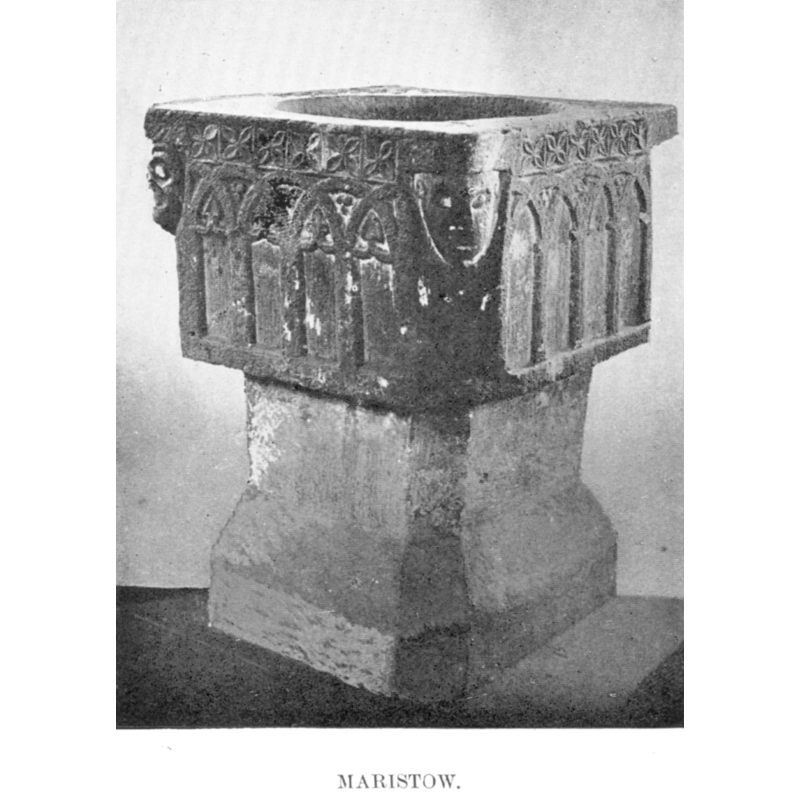Maristow / Marystow / Marystowe / Mary-Stow / Mary Stow

Image copyright © [in the public domain]
PD
Results: 7 records
B01: design element - architectural - arcade - blind - round arches - intersecting arches
B02: design element - motifs - leaf - lanceolated
B03: design element - motifs - leaf - trefoiled
B04: design element - motifs - floral - fleur-de-lis
BBU01: design element - motifs - floral - 4-petal - in a square
BH01: human figure - grotesque or fantastic - head - 4
INFORMATION
FontID: 06619MAR
Object Type: Baptismal Font1
Church/Chapel: Parish Church of St. Mary the Virgin
Church Patron Saints: St. Mary the Virgin
Country Name: England
Location: Devon, South West
Directions to Site: Located 6-7 km NW of Plymouth, 13 km SE of Launceston
Font Location in Church: Inside the church
Century and Period: 12th - 13th century, Late Norman / Transitional?
Cognate Fonts: Clarke [cf. infra] groups this font with the ones at Lifton and Stowford
Font Notes:
Click to view
Listed in Lysons (1806-1822) as one of a group of square baptismal fonts in the county that are "for the most part supported by four pillars and a large pedestal in the centre". Lewis' Dictionary of 1848 reports "an ancient font" in this church. Described in Worthy (1887): "The font is a very fine example of pure Norman work. It is square with a circular bason, is in good preservation and is profusely ornamented with grotesque heads at the angles, and with an arcade of circular arches intersecting each other." Listed in Cox & Harvey (1907) as having a baptismal font of the Norman period. Clarke (1921) writes that this is one of "a very interesting group of three fonts [Lifton and Stowford are the other two] which, though derived from the cushion bowls, retain none of their features except the corner masks. Maristow font appears to be the earliest. Like Ashwater and Bratton Clovelly [cf. Index entries] the rim is square in every dimension. At the angles it forms a cornice above the masks, below the masks the stone is chamfered off, so that in spite of its square appearance it is really an octagon. The main faces have an arcade of interlaced arches on three sides, making four lancet-shaped panelsand five triangular interspaces; on the north side there are only three panels, which are, of course, wider than the others. On the east and west faces the pilasters have a spare Norman abacus; this feature is preparing the way for the trefoil-headed lancet, as we shall see presently at Stowford; the panels are blank. The interspaces above on the east have each a trefoil, on the west two trefoils and a round pellet. On the north side at the point of each lancet-shaped panel is a conventional lily --the three-petalled fleur-de-lis (really the iris), which had so much vogue in the thirteenth century. The stem divides, curving to the right and left, joining the arches just at the spring, and taking the place of the square abacus on the east and west faces. Pointed trefoils fill the triangular interspaces: below the lilies the pabels are blank. The south face is similar to the north, though there are four panels instead of three, and the lilies are smaller, leaving more background. The central interspace is filled by a pointed trefoil, the side ones have groups of three pellets arranged as a trefoil. Above the interlaced arcades on all four sides is a carved band, 3 1/2 inches deep, consisting of a row of six four-leaved flowers. The corner pieces above the masks are rather narrow, and are perfectly plain." Noted in Pevsner (1952): "Norman, square, almost exactly as at Lifton."
MEDIUM AND MEASUREMENTS
Material: stone
Font Shape: square (mounted)
Basin Interior Shape: round
Basin Exterior Shape: square
Rim Thickness: 8 cm [calculated]
Diameter (inside rim): 57.5 cm*
Diameter (includes rim): 73.75 cm*
Basin Depth: 27.5 cm*
Basin Total Height: 46.25 cm*
Height of Central Column: 25 cm
Font Height (less Plinth): 97.5 cm*
Notes on Measurements: * [measurements given in inches in Clarke (1922: 223) -- NB: Clarke gives only "26 1/2 inches" as the measurement of the "base", but it probably refers to its diameter]
REFERENCES
Betjeman, John, An American's Guide to English Parish Churches (including the Isle of Man), New York: McDowell, Obolensky, 1958
Clarke, Kate M., "The baptismal fonts of Devon -- Part IX", 54, Report and Transactions of the Devonshire Association for the Advancement of Science, Literature and Art, 1922, pp. 216-223; p. 222, 223
Clarke, Kate M., "The baptismal fonts of Devon -- Part VIII", 53, Report and Transactions of the Devonshire Association for the Advancement of Science, Literature and Art, 1921, pp. 226-231; p. 228-229, 230, 231 and pl. I (opp. p. 229)
Cox, John Charles, English Church Furniture, New York: E.P. Dutton & Co., 1907
Lewis, Samuel, A Topographical Dictionary of England, Comprising the Several Counties, Cities, Boroughs, Corporate and Market Towns, Parishes, Chapelries, and Townships, and the Islands of Guernsy, Jersey, and Man, with Historical and Statistical Descriptions [...], London: S. Lewis, 1831
Lysons, Daniel, Magna Britannia, being a concise topographical account of the several counties of Great Britain, London: Printed for T. Cadell and W. Davies, 1806-1822
Pevsner, Nikolaus, South Devon, Harmondsworth: Penguin Books, 1952
Worthy, Charles, Devonshire parishes, or the antiquities, heraldry and family history of twenty-eight parishes in the Archdeaconry of Totnes, Exeter; London: William Pollard; George Redway, 1887